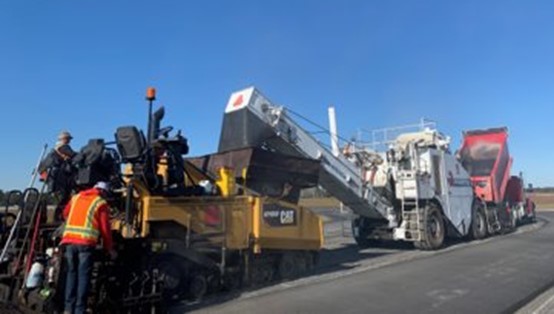
Innovations in air transportation and a major infusion of new state and federal funding will create economic opportunity in 2022 for companies with the experience and capacity to help airports build and maintain their infrastructure and push the boundaries of unmanned aviation.
That activity should increase the economic impact of North Carolina’s 72 public airports, which already contribute more than $61 billion to the state’s economy, as well as expand the state’s burgeoning drone economy.

“Public investments in aviation infrastructure will enable much-needed expansions and rehabilitation of public airport facilities, creating jobs and attracting new aerospace-related companies to our state,” says Bobby Walston, P.E., director of the North Carolina Department of Transportation’s Division of Aviation. “Meanwhile, we expect to continue opening the airways to unmanned aircraft in 2022, working with innovative companies and the Federal Aviation Administration to usher in this new era of air transportation.”
Aviation Division Advances N.C. Air Transportation
The NCDOT Division of Aviation leads innovation and activity that advances a robust air transportation system for North Carolina. That includes managing a range of state and federal grant programs to support infrastructure improvements at the state’s public airports to help them meet safety and community needs.
The Division provides planning and technical assistance for airports, a statewide program of infrastructure maintenance and federally mandated services, business development services and a unique general aviation airports economic development fund to expand investment at the airports and professional development programs for airport personnel.
The Division also oversees North Carolina’s unmanned aviation system and has positioned North Carolina as a national leader in enabling commercial and government drone use. It works closely with the Federal Aviation Administration (FAA) and innovative companies and government agencies to shape the regulations and practices that will enable unmanned aircraft to operate in the state.
As one of eight teams selected for the FAA’s BEYOND national drone integration initiative, the Division has direct access to federal regulators setting the terms of how drones can operate in low-altitude air space. Companies have taken note of North Carolina’s leadership and come to the state to partner with NCDOT in testing novel commercial drone services, gaining FAA approvals and launching operations.
Through this initiative, North Carolina has achieved more commercial drone missions and national firsts in business and government drone use than any state in the country, many supporting life-saving missions. Among them are deliveries of medical packages, from time-sensitive infusion medications to COVID vaccines, routinely operating in urban and rural areas. NCDOT uses drones to support first responders during hurricanes and to improve safety and efficiency of operations such as assessing rockslide damage and inspecting transportation infrastructure.
A recently released year-in-review video highlights the Division’s accomplishments in 2021.
Among those accomplishments was the release of the Division’s biennial economic impact study, called North Carolina: The State of Aviation. The report quantifies the impact of the state’s public airports system and highlights the state’s aviation infrastructure and assets, companies, military installations and educational programs that undergird it.
The 2021 report reveals that the state’s 72 public airports generate $61 billion in business revenues, support more than 373,000 jobs, provide $15 billion in personal income and return more than $2.5 billion in tax revenues to local and state governments.
Investments and Initiatives Coming in 2022
Looking ahead, innovations and expansions in both manned and unmanned aviation are expected in 2022.
On the manned side, a major infusion of nearly $280 million in state and federal grant funding will flow through the Division of Aviation for infrastructure development at the state’s 72 public airports in 2022.
State funding of $242.8 million is coming from:
- $75 million in annual funding for infrastructure improvements at the state’s 10 commercial service airports.
- $52.7 million in funding from the Division’s annual State Aid to Airports grant program.
- $11
- 5.1 million for 18 airports allocated from the state Capital and Infrastructure Fund.
Federal funding of $35.25 million is coming from:
- $12.35 million for infrastructure improvements to 61 eligible general aviation airports from the 2021 Bipartisan Infrastructure Law (BLI). Airports will receive tiered grants of $110,000, $159,000, $295,000 and $763,000 based on their standing in the National Plan of Integrated Airport Systems. (The BLI also will provide $79.35 million directly to the state’s 10 commercial service airports, in amounts ranging from $1 million to $43 million based on passenger enplanements.)
- $20.4 million in FFY 2021 Airport Improvement Program and American Rescue Plan Act funding from the Federal Aviation Administration for airport infrastructure development projects at the state’s general aviation airports.
- $2.5 million in a third round of COVID relief funding, also from the American Rescue Plan, to cover operational expenses at general aviation airports.
The Division will continue expanding its services to support the state’s airports with professional development training that strengthens leadership and management of public airports, as well as working with airports and state economic developers to attract aviation and airport-related companies and jobs.
A new grant program will provide funds to North Carolina public airports for aviation camps for middle and high school students in the summer of 2022. The N.C. ACE Academies Grant Fund will relaunch previously funded week-long Aviation Career Education (ACE) summer camps to expose youth to a variety of high-demand aviation careers and give them a solid foundation of aerospace knowledge.
On the unmanned side, the Division of Aviation’s Unmanned Aircraft Systems (UAS) Program will focus on developing the infrastructure and procedures by which drones can be used to carry ever-larger payloads of cargo, and ultimately people.
The Division’s focus in the BEYOND initiative is to enable unmanned aircraft that can carry larger cargo loads with greater efficiency and low environmental impact, and gaining FAA approval of missions that occur beyond the visual line of sight (BVLOS) of the operator. Achieving routine BVLOS missions will unleash the full potential of commercial and government use of drones. A $5 million grant from the 2021 N.C. General Assembly will be used to begin building a model for urban advanced air mobility system in the state in 2022.
NCDOT Secretary Eric Boyette recently told a national audience: “Jeff Bezos in a 60 Minutes interview in 2013 announced an experimental drone delivery service, indicating it would take four to five years to turn this R&D project into a reality. Little did he know he would go to space before Amazon would see widespread drone delivery operations.”
UAS integration is a complex regulatory process, but North Carolina has been successful in launching routine drone delivery operations in seven locations across the state. One company is now delivering fast food by drone to backyards in three N.C. communities.
Most of N.C.’s UAS operations are conducted in partnership with hospital and healthcare systems, delivering specimens, medicine and personal protective equipment that have supported the state’s COVID response. A recent test investigated using drones to deliver critical supplies to the residents of Ocracoke Island in the event they are cut off after a hurricane. Another completed the nation’s first drone delivery of COVID vaccine.
Using drones to shuttle vaccines and other pharmaceuticals across healthcare networks can dramatically improve productivity. Additionally, these operations are conducted by automated, battery-powered drones that produce zero operational emissions, and their cargo is subjected to less vibrations than packages moved by ground transportation.
All of these experiences well-position North Carolina to expand advanced air mobility in communities in 2022.
For more information on the Division of Aviation and its initiatives, visit www.ncdot.gov/aviation.


